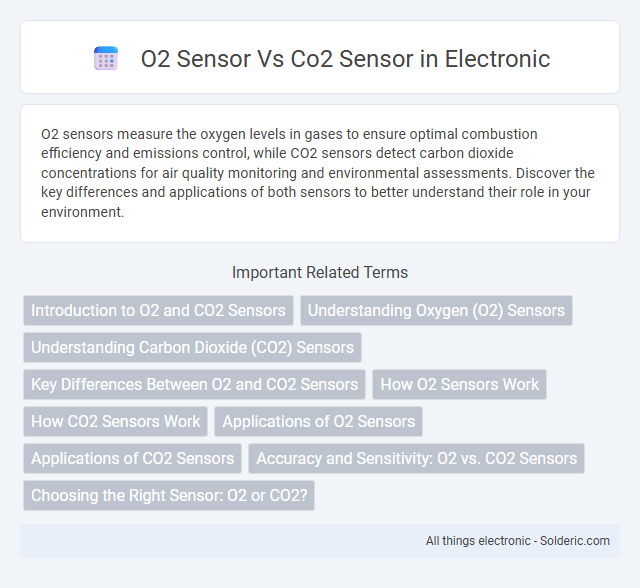O2 sensors measure the oxygen levels in gases to ensure optimal combustion efficiency and emissions control, while CO2 sensors detect carbon dioxide concentrations for air quality monitoring and environmental assessments. Discover the key differences and applications of both sensors to better understand their role in your environment.
Comparison Table
| Feature | O2 Sensor | CO2 Sensor |
|---|---|---|
| Measurement Target | Oxygen (O2) concentration in air | Carbon dioxide (CO2) concentration in air |
| Common Applications | Automotive emission control, medical devices, industrial processes | Indoor air quality monitoring, HVAC systems, greenhouse gas detection |
| Sensor Type | Electrochemical, zirconia, paramagnetic | NDIR (Non-Dispersive Infrared), chemical sensors |
| Measurement Units | Percentage (%) of oxygen concentration | Parts per million (ppm) of carbon dioxide |
| Response Time | Typically fast (seconds) | Moderate (seconds to minutes) |
| Operating Environment | Automotive exhaust gases, medical air, industrial gases | Indoor environments, greenhouses, industrial emissions |
| Price Range | Moderate to high, depending on sensor technology | Moderate, NDIR sensors are common |
| Calibration Frequency | Regular calibration recommended | Periodic calibration required |
Introduction to O2 and CO2 Sensors
O2 sensors measure the concentration of oxygen in gases and are essential for monitoring combustion efficiency and air-fuel ratios in engines. CO2 sensors detect carbon dioxide levels to assess air quality and monitor environmental conditions, especially in indoor spaces or carbon capture systems. Your choice between O2 and CO2 sensors depends on the specific application requirements for gas detection and control.
Understanding Oxygen (O2) Sensors
Oxygen (O2) sensors measure the concentration of oxygen in exhaust gases to optimize combustion efficiency and reduce emissions. These sensors provide real-time feedback to the engine control unit, ensuring precise air-fuel mixture adjustment for better fuel economy. Unlike CO2 sensors that detect carbon dioxide levels, O2 sensors play a critical role in maintaining optimal engine performance and minimizing harmful pollutants.
Understanding Carbon Dioxide (CO2) Sensors
Carbon dioxide (CO2) sensors detect and measure CO2 concentration levels in the air using infrared (NDIR) technology, providing precise monitoring crucial for indoor air quality, HVAC systems, and environmental studies. Unlike oxygen (O2) sensors that focus on oxygen levels and operate via electrochemical or galvanic methods, CO2 sensors specifically quantify carbon dioxide to assess ventilation efficiency and occupant safety. High-performance CO2 sensors offer rapid response times, low detection limits, and minimal cross-sensitivity, ensuring accurate real-time data critical for health and industrial applications.
Key Differences Between O2 and CO2 Sensors
O2 sensors measure oxygen levels primarily in automotive exhaust systems to optimize fuel combustion, while CO2 sensors detect carbon dioxide concentration in air quality and environmental monitoring. O2 sensors operate by generating a voltage based on oxygen partial pressure, whereas CO2 sensors typically rely on infrared absorption technology for precise gas detection. The key distinction lies in their target gases and applications: O2 sensors enhance engine efficiency, and CO2 sensors monitor indoor air quality or industrial emissions.
How O2 Sensors Work
O2 sensors measure the oxygen concentration in a vehicle's exhaust gases by generating a voltage based on the difference between the oxygen levels in the exhaust and the ambient air, allowing the engine control unit (ECU) to adjust the air-fuel mixture for optimal combustion. This electrochemical sensor typically uses a zirconia or titania ceramic element that reacts with oxygen ions to produce the voltage signal. Unlike CO2 sensors, which quantify carbon dioxide levels, O2 sensors are critical for real-time feedback on combustion efficiency and emissions control.
How CO2 Sensors Work
CO2 sensors measure carbon dioxide concentration by detecting the amount of infrared light absorbed by CO2 molecules in the air, using non-dispersive infrared (NDIR) technology to provide accurate readings. Unlike O2 sensors that monitor oxygen levels through electrochemical reactions, CO2 sensors assess air quality by analyzing gas absorption patterns. Your indoor air quality can be effectively managed with CO2 sensors, ensuring optimal ventilation and reducing the risk of elevated CO2 levels.
Applications of O2 Sensors
O2 sensors are primarily used in automotive exhaust systems to monitor oxygen levels and optimize fuel combustion, improving engine efficiency and reducing emissions. They are also employed in industrial processes such as combustion control in boilers and furnaces to ensure safety and energy efficiency. In medical applications, O2 sensors help regulate oxygen delivery in respiratory devices and anesthesia machines.
Applications of CO2 Sensors
CO2 sensors are widely used in applications such as indoor air quality monitoring, HVAC systems, and environmental control in greenhouses and offices. They provide critical data for optimizing ventilation and ensuring healthy air conditions. Your ability to maintain optimal CO2 levels helps improve comfort and energy efficiency in various settings.
Accuracy and Sensitivity: O2 vs. CO2 Sensors
O2 sensors typically provide higher accuracy and faster response times for measuring oxygen concentration in combustion and environmental applications due to their electrochemical or zirconia-based technology. CO2 sensors, often based on infrared (NDIR) technology, offer excellent sensitivity to carbon dioxide levels but may have slower response times and require periodic calibration to maintain precision. The choice between O2 and CO2 sensors depends on the specific gas detection needs, with O2 sensors excelling in oxygen measurement accuracy and CO2 sensors optimized for detecting trace amounts of carbon dioxide.
Choosing the Right Sensor: O2 or CO2?
Choosing the right sensor depends on the specific application needs: O2 sensors measure oxygen concentration critical for combustion control and medical monitoring, while CO2 sensors detect carbon dioxide levels vital for indoor air quality and environmental studies. O2 sensors typically use electrochemical or zirconia technology, offering high sensitivity to oxygen variations, whereas CO2 sensors often rely on nondispersive infrared (NDIR) technology for precise carbon dioxide measurement. Understanding the gas to be monitored and the desired accuracy, response time, and operating environment ensures optimal sensor selection between O2 and CO2 options.
o2 sensor vs co2 sensor Infographic

 solderic.com
solderic.com